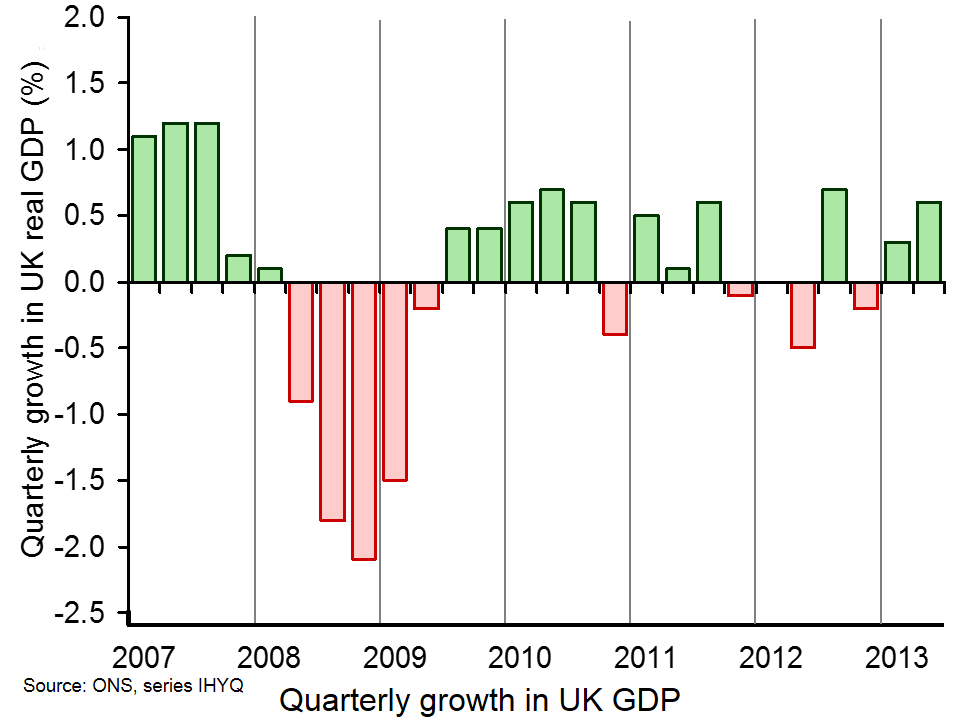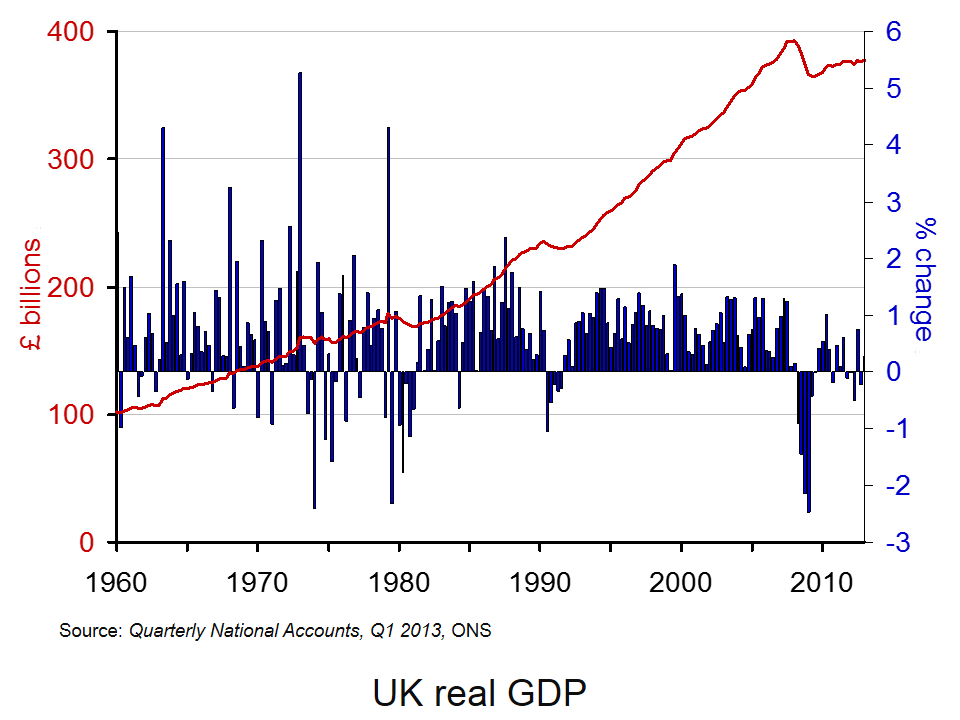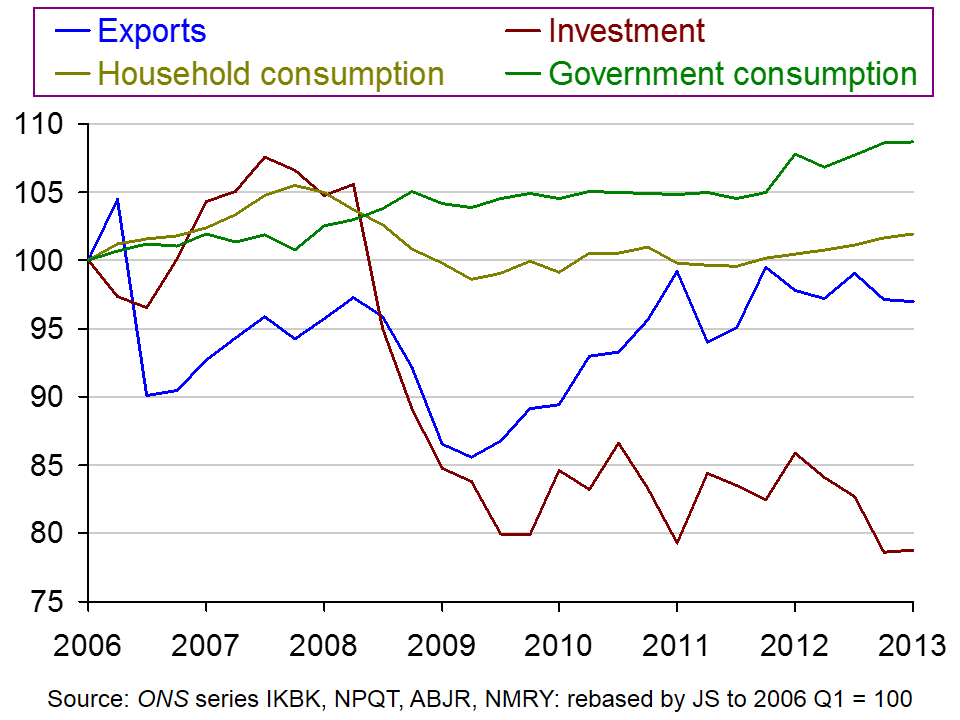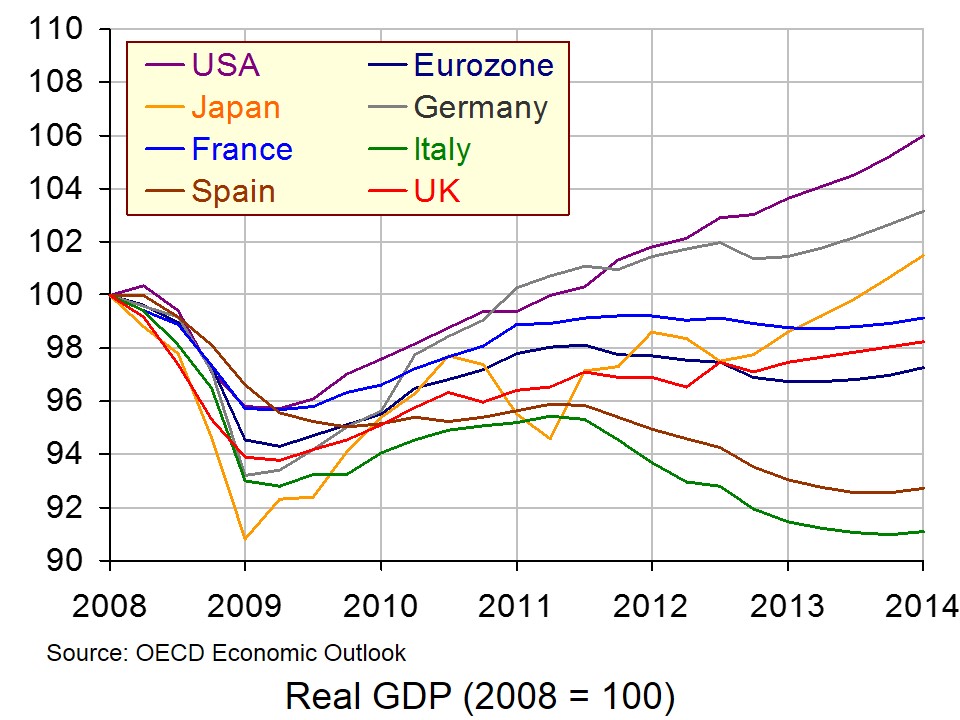 Tight fiscal policies are being pursued in many countries to deal with high public-sector deficits that resulted from the deep recession of 2008/9. This has put the main onus on monetary policy as the means of stimulating recovery. As a result we have seen record low interest rates around the world, set at only slightly above zero in the main industrialised countries for the past 4½ years. In addition, there have been large increases in narrow money as a result of massive programmes of quantitative easing.
Tight fiscal policies are being pursued in many countries to deal with high public-sector deficits that resulted from the deep recession of 2008/9. This has put the main onus on monetary policy as the means of stimulating recovery. As a result we have seen record low interest rates around the world, set at only slightly above zero in the main industrialised countries for the past 4½ years. In addition, there have been large increases in narrow money as a result of massive programmes of quantitative easing.
Yet recovery remains fragile in many countries, including the UK and much of the rest of Europe. And a new problem has been worries by potential investors that loose monetary policy may be soon coming to an end. As the June blog The difficult exit from cheap money pointed out:
The US economy has been showing stronger growth in recent months and, as a result, the Fed has indicated that it may soon have to begin tightening monetary policy. It is not doing so yet, nor are other central banks, but the concern that this may happen in the medium term has been enough to persuade many investors that stock markets are likely to fall as money eventually becomes tighter. Given the high degree of speculation on stock markets, this has led to a large-scale selling of shares as investors try to ‘get ahead of the curve’.
Central banks have responded with a new approach to monetary policy. This is known as ‘forward guidance’. The idea is to manage expectations by saying what the central bank will do over the coming months.
The USA was the first to pursue this approach. In September 2012 the Fed committed to bond purchase of $40bn per month (increased to $85bn per month in January 2013) for the foreseeable future; and record low interest rates of between 0% and 0.25% would continue. Indeed, as pointed out above, it was the ‘guidance’ last month that such a policy would be tapered off at some point, that sent stock markets falling in June.
The Fed has since revised its guidance. On 10 July, Ben Bernanke, the Fed Chairman said that monetary policy would not be tightened for the foreseeable future. With fiscal policy having been tightened, QE would continue and interest rates would not be raised until unemployment had fallen to 6.5%.
Japan has been issuing forward guidance since last December. Its declared aim has been to lower the exchange rate and raise inflation. It would take whatever fiscal and monetary policies were deemed necessary to achieve this (see A J-curve for Japan? and Japan’s three arrows).
Then on 4 July both the Bank of England and the ECB adopted forward guidance too. Worried that growth in the US economy would lead to an end to loose monetary policy before too long and that this would drive up interest rates worldwide, both central banks committed to keeping interest rates low for an extended period of time. Indeed, the ECB declared that the next movement in interest rates would more likely be down than up. Mario Draghi, the ECB president said that the ending of loose monetary policy is ‘very distant’.
The effect of this forward guidance has been to boost stock markets again. The hope is that by managing expectations in this way, the real economy will be affected too, with increased confidence leading to higher investment and faster economic growth.
 Update (8/8/13)
Update (8/8/13)
With the publication of its August 2013 Inflation Report, the Bank of England clarified its approach to forward guidance. It was announced that Bank Rate would stay at the current historically low level of 0.5% ‘at least until the Labour Force Survey headline measure of unemployment has fallen to a threshold of 7%’. In his Inflation Report Press Conference opening remarks, Mark Carney, Governor of the Bank of England, also stated that:
While the unemployment rate remains above 7%, the MPC stands ready to undertake further asset purchases if further stimulus is warranted. But until the unemployment threshold is reached the MPC intends not to reduce the stock of asset purchases from the current £375 billion.
Nevertheless, the Bank reserved the right to abondon this undertaking under cirtain circumstances. As Mark Carney put it:
The Bank of England’s unwavering commitment to price stability and financial stability is such that this threshold guidance will cease to apply if material risks to either are judged to have arisen. In that event, the unemployment threshold would be ‘knocked out’. The guidance will remain in place only if, in the MPC’s view, CPI inflation 18 to 24 months ahead is more likely than not to be below 2.5%, medium-term inflation expectations remain sufficiently well anchored, and the FPC has not judged that the stance of monetary policy poses a significant threat to financial stability that cannot otherwise be contained through the considerable supervisory and regulatory policy tools of the various authorities. The two inflation knockouts ensure that the guidance remains fully consistent with our primary objective of price stability. The financial stability knockout takes full advantage of the new institutional structure at the Bank of England, ensuring that monetary and macroprudential policies coordinate to support a sustainable recovery. The knock-outs would not necessarily trigger an increase in Bank Rate – they would instead be a prompt for the MPC to reconsider the appropriate stance of policy.
Similarly, it is important to be clear that Bank Rate will not automatically be increased when the unemployment threshold is reached. Nor is 7% a target for unemployment. The rate of unemployment consistent with medium-term price stability – a rate that monetary policy can do little to affect – is likely to be lower than this. So 7% is merely a ‘way station’ at which the MPC will reassess the state of the economy, the progress of the economic recovery, and, in that context, the appropriate stance of monetary policy.
The articles in the updated section below consider the implications of this forward guidance and the caveat that the undertaking might be abondoned in certain circumstances.
Articles
Q&A: What is ‘forward guidance’ BBC News, Laurence Knight (4/7/13)
Forward guidance crosses the Atlantic The Economist, P.W. (4/7/13)
ECB has no plans to exit loose policies, says Benoit Coeure The Telegraph, Szu Ping Chan (25/6/13)
ECB issues unprecedented forward guidance The Telegraph, Denise Roland (4/7/13)
Independence day for central banks BBC News, Stephanie Flanders (4/7/13)
The Monetary Policy Committee’s search for guidance BBC News, Stephanie Flanders (16/7/13)
The Monetary Policy Committee’s search for guidance (II) BBC News, Stephanie Flanders (17/7/13)
Bank of England surprise statement sends markets up and sterling tumbling The Guardian, Jill Treanor and Angela Monaghan (4/7/13)
Forward guidance only works if you do it right Financial Times, Wolfgang Münchau (7/7/13)
Fed’s Forward Guidance Failing to Deliver Wall Street Journal, Nick Hastings (15/7/13)
Talking Point: Thoughts on ECB forward guidance Financial Times, Dave Shellock (11/7/13)
Forward guidance in the UK is likely to fail as the Fed taper approaches City A.M., Peter Warburton (12/7/13)
Forward guidance more than passing fashion for central banks Reuters, Sakari Suoninen (11/7/13)
Markets await Mark Carney’s ‘forward guidance’ The Guardian, Heather Stewart (17/7/13)
Beware Guidance The Economist, George Buckley (25/7/13)
Articles for update
The watered down version of Forward Guidance Reuters, Kathleen Brooks (8/8/13)
Clarity Versus Flexibility at the Bank of England Bloomberg (7/8/13)
Mark Carney’s guidance leaves financial markets feeling lost Independent, Ben Chu (8/8/13)
Bank links interest rates to unemployment target BBC News (7/8/13)
Mark Carney says forward guidance should boost economy BBC News (8/8/13)
The Bank’s new guidance BBC News, Stephanie Flanders (7/8/13)
Uncertainty over BoE guidance lifts sterling to 7-week peak Reuters, Spriha Srivastava (8/8/13)
Bank of England’s guidance is clear, say most economists: Poll The Economic Times (8/8/13)
Britain’s economy: How is it really doing? The Economist (10/8/13)
Markets give thumbs down to Mark Carney’s latest push on forward guidance The Guardian, Larry Elliott (28/8/13)
Carney’s guidance on guidance BBC News, Stephanie Flanders (28/8/13)
Webcasts and podcasts for update
 Inflation Report Press Conference Bank of England (7/8/13)
Inflation Report Press Conference Bank of England (7/8/13)
 Interest rates to be held until unemployment drops to 7% BBC News, Extracts of Statement by Mark Carney, Governor of the Band of England (7/8/13)
Interest rates to be held until unemployment drops to 7% BBC News, Extracts of Statement by Mark Carney, Governor of the Band of England (7/8/13)
 Bank of England links rates to unemployment target BBC News (7/8/13)
Bank of England links rates to unemployment target BBC News (7/8/13)
 Mark Carney: Financial institutions ‘have to change culture’ BBC Today Programme (8/8/13)
Mark Carney: Financial institutions ‘have to change culture’ BBC Today Programme (8/8/13)
 Bank of England’s Mark Carney announces rates held BBC News. John Moylan (7/8/13)
Bank of England’s Mark Carney announces rates held BBC News. John Moylan (7/8/13)
Central Bank Statements and Speeches
How does forward guidance about the Federal Reserve’s target for the federal funds rate support the economic recovery? Federal Reserve (19/6/13)
Remit for the Monetary Policy Committee HM Treasury (20/3/13)
Bank of England maintains Bank Rate at 0.5% and the size of the Asset Purchase Programme at £375 billion Bank of England (4/7/13)
Monthly Bulletin ECB (see Box 1) (July 2013)
Inflation Report Press Conference: Opening remarks by the Governor Bank of England (7/8/13)
MPC document on Monetary policy trade-offs and forward guidance Bank of England (7/8/13)
Monetary policy and forward guidance in the UK Bank of England, David Miles (24/9/13)
Monetary strategy and prospects Bank of England, Paul Tucker (24/9/13)
Questions
- Is forward guidance a ‘rules-based’ or ‘discretion-based’ approach to monetary policy?
- Is it possible to provide forward guidance while at the same time pursuing an inflation target?
- If people know that central banks are trying to manage expectations, will this help or hinder central banks?
- Does the adoption of forward guidance by the Bank of England and ECB make them more or less dependent on the Fed’s policy?
- Why may forward guidance be a more effective means of controlling interest rates on long-term bonds (and other long-term rates too) than the traditional policy of setting the repo rate on a month-by-month basis?
- What will determine the likely success of forward guidance in determining long-term bond rates?
- Is forward guidance likely to make stock market speculation less destabilising?
- Is what ways is the ‘threshold guidance’ by the Bank of England likely to make the current expansionary stance of monetary policy more effective?
- Is 7% the ‘natural rate of unemployment’? Explain your reasoning.
 The Preliminary Estimate of the UK Q2 GDP figures by the Office for National Statistics show that the UK economy grew by 0.6% in the second quarter of 2013: double the growth rate of the first quarter and almost back to the long-run average growth rate prior to 2008.
The Preliminary Estimate of the UK Q2 GDP figures by the Office for National Statistics show that the UK economy grew by 0.6% in the second quarter of 2013: double the growth rate of the first quarter and almost back to the long-run average growth rate prior to 2008.
At first sight, this would seem to be good news – certainly from the government’s point of view. What is more, unlike the previous quarter, growth is spread relatively evenly across the three main sectors: the production (manufacturing, mining, water supply, etc.) and services sectors both grew by 0.6% and the construction sector by 0.9% (this sector fell by 1.8% in the previous quarter). (Click here for a PowerPoint of the chart below.)
 But while growth in the latest quarter may be balanced between the broad sectors, the rise in aggregate demand is not balanced between its components. As an earlier news item (A balancing act) showed, the rise in aggregate demand has been driven largely by a rise in consumption, and a corresponding fall in saving. Exports are rising only slowly and investment is some 25% lower than in the boom years prior to 2008.
But while growth in the latest quarter may be balanced between the broad sectors, the rise in aggregate demand is not balanced between its components. As an earlier news item (A balancing act) showed, the rise in aggregate demand has been driven largely by a rise in consumption, and a corresponding fall in saving. Exports are rising only slowly and investment is some 25% lower than in the boom years prior to 2008.
So will the latest growth be sustainable? Will investment now begin to pick up and what constraints are there on investment? The following articles consider some of the issues.
Articles
Economy firing on all cylinders as growth hits 0.6pc The Telegraph, Philip Aldrick (25/7/13)
The good, the bad or the ugly? How the UK economy stands up. The Telegraph, Philip Aldrick (25/7/13)
George Osborne’s 0.6% growth is good but unspectacular The Guardian, Larry Elliott (25/7/13)
The (not-so) green shoots of recovery The Economist, John Van Reenen (23/7/13)
Economic recovery slow to take root for some in UK Reuters, William Schomberg and Max De Haldevang (25/7/13)
 GDP figures offer hard evidence for political narrative BBC News, Paul Mason (25/7/13)
GDP figures offer hard evidence for political narrative BBC News, Paul Mason (25/7/13)
Ignore the hype: Britain’s ‘recovery’ is a fantasy that hides our weakness The Observer, Will Hutton (21/7/13)
UK economy: Half-speed ahead BBC News, Stephanie Flanders (25/7/13)
BoE guidance can help sustain the UK recovery The Economist, Kevin Daly (22/7/13)
George Osborne’s description of the economy is near-Orwellian The Guardian, Ha-Joon Chang (26/7/13)
Economic growth: more must be done to encourage investment The Guardian, Phillip Inman (1/8/13)
Data
Gross Domestic Product: Preliminary Estimate, Q2 2013 ONS (25/7/13)
Questions
- Compare the macroeconomic situation today with that prior to the financial crisis of 2007/8 and subsequent recession.
- What factors will determine the sustainability of the UK economic recovery?
- What is meant by the ‘accelerator’ and what will determine the size of any accelerator effect from the latest rise in UK GDP?
- What supply-side constraints are likely to limit the rate and extent of recovery?
- Why do economies that are in recession ‘naturally bounce back’ without any government intervention? Have the macroeconomic policies of the UK government helped or hindered this bounce back? Explain.
- What monetary measures by the Bank of England are most appropriate in the current circumstances?
 One very important characteristic of economic growth is its short-term volatility. Economic activity is notoriously volatile. It is such a fundamental idea that economists refer to it as one of their threshold concepts. The volatility of growth sees occasional recessions. The traditional definition is where real GDP (output) declines for 2 or more consecutive quarters. The latest figures from the Quarterly National Accounts call into question whether the UK technically experienced a recession at the start of 2012 with output broadly flat in 2012 Q1 following a contraction of 0.1 per cent in 2011 Q4.
One very important characteristic of economic growth is its short-term volatility. Economic activity is notoriously volatile. It is such a fundamental idea that economists refer to it as one of their threshold concepts. The volatility of growth sees occasional recessions. The traditional definition is where real GDP (output) declines for 2 or more consecutive quarters. The latest figures from the Quarterly National Accounts call into question whether the UK technically experienced a recession at the start of 2012 with output broadly flat in 2012 Q1 following a contraction of 0.1 per cent in 2011 Q4.
The ONS’s latest output numbers raise some interesting questions around our understanding of what constitutes a recession. These figures show that the 2008/9 recession was deeper than first thought with output declining by 7.2 per cent. They show that UK output peaked in 2008Q1 (£392.786 billion at 2010 prices). There then followed 6 quarters where output declined.
Output declined again in 2010 Q4 (–0.2% growth) and again in 2011 Q4 (–0.1% growth). But then interpretations of the data become more controversial. Not least, we get in the debates concerning the accuracy with which we can expect to measure the size of the economy and so to how many decimal places one should realistically measure a rise or fall. In terms of the raw real GDP numbers output fell in 2012 Q1. In 2011 Q4 GDP is estimated at £376,462 billion (at 2010 prices) ‘falling’ to £376,436 billion (at 2010 prices) in 2012 Q1. But, this is a percentage fall only when measured to the third decimal place (–0.007% growth).
In its publication Impact of changes in the National Accounts and economic commentary for Q1 2013 the ONS argue that:
While some commentators may attempt to read some significance into this revision, particularly in the context of whether the UK experienced a “double-dip” recession, it is clearly absurd to imagine that it is possible to measure the size of the economy to this degree of accuracy. The best interpretation of the Blue Book figures is that the economy was flat in the first quarter of 2012, and 0.6% larger than in the same quarter of 2011.
It is however understandable that those with vested interests – including economists, policy-makers and politicians – will take a slightly different view and will read more into the figures than perhaps an objective, sober view might demand. What appears more certain is that output did again fall in 2012 Q2 (–0.5 per cent growth) and in 2012 Q4 (–0.2 per cent growth). Despite estimated growth of 0.3 per cent in 2013 Q1, output remains 3.9 per cent lower than at its 2008 Q1 peak.
Perhaps the ‘absurdity’ or not around the debate of a double-dip recessions strengthens the argument for a more holistic and considered view of what constitutes a recession. In the USA the wonderfully-named Business Cycle Dating Committee takes a less fixed view of economic activity and, hence, of recessions. Its website argues:
It (the Committee) examines and compares the behavior of various measures of broad activity: real GDP measured on the product and income sides, economy-wide employment, and real income. The Committee also may consider indicators that do not cover the entire economy, such as real sales and the Federal Reserve’s index of industrial production (IP).
Of course, the advantage of focusing on real GDP alone in measuring activity and in determining recessions is that it is usually very straightforward to interpret. Regardless of whether the UK has experienced or not two recessions in close proximity, our chart helps to put the recent growth numbers into an historical context . It shows both the quarter-to-quarter changes in real GDP (left-hand axis) and the level of output as measured by GDP at constant 2010 prices (right-hand axis). Click here to download the chart to PowerPoint.
. It shows both the quarter-to-quarter changes in real GDP (left-hand axis) and the level of output as measured by GDP at constant 2010 prices (right-hand axis). Click here to download the chart to PowerPoint.
The chart captures nicely the twin characteristics of growth. Since 1960, the average rate of growth per quarter has been 0.63 per cent. This is equivalent to an average rate of growth of 2.55 per cent per year. Since 2008 Q2, quarterly growth has averaged –0.19 per cent which is equivalent to an annual rate of growth of –0.78 per cent! In any language these are extraordinary numbers. Indeed, one could argue that focusing any policy debate around whether or not the UK experienced a double-dip recession rather misses the more general point concerning the absense of any sustained economic growth since 2008.
Data
Quarterly National Accounts Time Series Dataset Q1 2013 Office for National StatisticsStatistical Bulletin: Quarterly National Accounts Q1 2013 Office for National Statistics
Articles
UK avoided double-dip recession in 2011, revised official data shows Guardian, Phillip Inman (27/6/13)
Britain’s double dip recession revised away, but picture still grim Reuters, David Milliken and William Schomberg (27/6/13)
UK double-dip recession revised away BBC News (27/6/13)
IMF raises UK economic growth forecast BBC News (9/7/13)
IMF raises UK economic growth forecast to 0.9% but cuts prediction for global growth Independent, Holly Williams (9/7/13)
IMF Upgrades UK Growth Forecast For 2013 Sky News (9/7/13)
Questions
- What is the difference between nominal and real GDP? Which of these helps to track changes in economic output?
- Looking at the chart above, summarise the key patterns in real GDP since the 1960s.
- What is a recession? What is a double-dip recession?
- What are some of the problems with the traditional definition of a recession?
- Explain the arguments for and against the proposition that the UK has recently experienced a double-dip recession.
- Can a recession occur if nominal GDP is actually rising? Explain your answer.
- What factors might result in economic growth being so variable?
- Produce a short briefing paper exploring the prospects for economic growth in the UK over the next 12 to 18 months.
 There’s some good news and some bad news about the UK economy. The good news is that there are signs that the recovery is gathering momentum; the ‘green shoots’ are growing bigger. The bad news is that it’s the ‘wrong type of growth’!
There’s some good news and some bad news about the UK economy. The good news is that there are signs that the recovery is gathering momentum; the ‘green shoots’ are growing bigger. The bad news is that it’s the ‘wrong type of growth’!
One of the main underlying problems of the 2008 financial crisis was that household debt had been increasing to unsustainable levels, egged on by banks only too willing to lend, whether as personal loans, on credit cards or through mortgages. When the recession hit, many people sought to reduce their debts by cutting back on spending. This further fuelled the recession.
What the government and most economists hoped was that there would be some rebalancing of the economy, with less reliance on consumer spending to drive economic growth. Instead it was hoped that growth would be driven by a rise in investment and exports. Indeed, the 25% depreciation of sterling exchange between 2007 and 2009 was seen as a major advantage as this would boost the demand for exports and encourage firms to invest in the export sector.
But things haven’t turned out the way people hoped. The recession (or lack of growth) has been much deeper and more prolonged than previous downturns in the economy. Today, real GDP per head is more than 7% below the level in 2007 and many people have seen much bigger declines in their living standards.
 But also, despite the austerity policies, the economy has not been ‘rebalanced’ towards exports and investment. Exports are 3% lower than in 2006 (although they did grow between 2009 Q2 and 2011 Q1, but have since stagnated). And investment is 27% lower than in 2006. Household consumption, however, has grown by about 2% and general government consumption by around 9% since 2006. The chart shows the figures, based on 2006 Q1 = 100.
But also, despite the austerity policies, the economy has not been ‘rebalanced’ towards exports and investment. Exports are 3% lower than in 2006 (although they did grow between 2009 Q2 and 2011 Q1, but have since stagnated). And investment is 27% lower than in 2006. Household consumption, however, has grown by about 2% and general government consumption by around 9% since 2006. The chart shows the figures, based on 2006 Q1 = 100.
(Click here for a PowerPoint of the chart.)
And recent evidence is that consumption is beginning to grow faster – not because of rising household incomes, but because of falling saving rates. In 2008, the household saving ratio had fallen to nearly 0% (i.e. households were on average saving about the same as they were borrowing). Then the saving ratio rose dramatically as people reined in their spending. Between 2009 and 2012, the ratio hovered around 7%. But in the first quarter of 2013, it had fallen to 4.2%
So the good news is that aggregate demand is rising, boosting economic growth. But the bad news is that, at least for the time being, this growth is being driven by a rise in household borrowing and a fall in household saving. The videos and articles consider whether this is, however, still good news on balance.
Webcasts
 Britain’s imbalanced economy The Economist, Zanny Minton Beddoes and Richard Davies (4/7/13)
Britain’s imbalanced economy The Economist, Zanny Minton Beddoes and Richard Davies (4/7/13)
 Britain’s Export Drought: an enduring disappointment The Economist, Andrew Palmer and Richard Davies (9/2/13)
Britain’s Export Drought: an enduring disappointment The Economist, Andrew Palmer and Richard Davies (9/2/13)
 ‘Green shoots’ of economic recovery in Rugby BBC News, Paul Mason (12/6/13)
‘Green shoots’ of economic recovery in Rugby BBC News, Paul Mason (12/6/13)
Articles
Is the UK economy seeing the ‘wrong kind’ of green shoots? BBC News, Stephanie Flanders (3/7/13)
The export drought: Better out than in The Economist (9/2/13)
Exports and the economy: Made in Britain The Economist (21/1/12)
The economy: On a wing and a credit card The Economist (6/7/13)
Unbalanced and unsustainable – this is the wrong kind of growth The Telegraph, Jeremy Warner (8/7/13)
The UK economy’s looking up – but no one’s told manufacturers The Guardian, Heather Stewart (10/7/13)
Data
Quarterly National Accounts, Q1 2013 (27/6/13)
Forecasts for the UK economy: a comparison of independent forecasts HM Treasury (June 2013)
ISM Manufacturing Report on Business® PMI History Institute for Supply Management
Questions
- What are forecasters expecting to happen to economic growth in the coming months? Why?
- What factors determine investment? Why has it fallen so substantially in the UK?
- Explain what is meant by the ‘accelerator’. Is the rise in consumption likely to lead to an accelerator effect and, if so, what will determine the size of this effect?
- Why have exports not grown more rapidly despite the depreciation of sterling after 2007?
- What will determine the rate of potential economic growth in the UK economy? How will a rise in real GDP driven by a rise in consumption impact on potential GDP and potential economic growth?
- What supply-side policies would you recommend, and why, in order to increase potential economic growth?
 The ‘Classical’ Treasury view of the 1920s and 30s was that extra government spending or tax cuts were not the solution to depression and mass unemployment. Instead, it would crowd out private expenditure if the money supply were not allowed to rise as it would drive up interest rates. But if money supply were allowed to rise, this would be inflationary. The solution was to reduce budget deficits to increase confidence in public finances and to encourage private investment. Greater price and wage flexibility were the answer to markets not clearing.
The ‘Classical’ Treasury view of the 1920s and 30s was that extra government spending or tax cuts were not the solution to depression and mass unemployment. Instead, it would crowd out private expenditure if the money supply were not allowed to rise as it would drive up interest rates. But if money supply were allowed to rise, this would be inflationary. The solution was to reduce budget deficits to increase confidence in public finances and to encourage private investment. Greater price and wage flexibility were the answer to markets not clearing.
Keynes countered these arguments by arguing that the economy could settle in a state of mass unemployment, with low confidence leading to lower consumer expenditure, lower investment, lower incomes and lower employment. The situation would be made worse, not better, by cuts in public expenditure or tax rises in an attempt to reduce the budget deficit. The solution was higher public expenditure to stimulate aggregate demand. This could be achieved by fiscal and monetary policies. Monetary policy alone could, however, be made ineffective by the liquidity trap. Extra money might simply be held rather than spent.
 This old debate has been reborn since the financial crisis of 2007/8 and the subsequent deep recession and, more recently, the lack of recovery. (Click here for a PowerPoint of the chart.)
This old debate has been reborn since the financial crisis of 2007/8 and the subsequent deep recession and, more recently, the lack of recovery. (Click here for a PowerPoint of the chart.)
The articles below consider the current situation. Many economists, but certainly not all, take a Keynesian line that austerity policies to reduce public-sector deficits have been counter-productive. By dampening demand, such policies have reduced national income and slowed the recovery in both investment and consumer demand. This has at best slowed the rate of deficit reduction or at worst even increased the deficit, with lower GDP leading to a reduction in tax receipts and higher unemployment leading to higher government social security expenditure.
Although monetary policy has been very loose, measures such as record low interest rates and quantitative easing have been largely ineffective in stimulating demand. Economies are stuck in a liquidity trap, with banks preferring to build their reserves rather than to increase lending. This is the result partly of a lack of confidence and partly of pressure on them to meet Basel II and III requirements of reducing their leverage.
But despite the call from many economists to use fiscal policy and more radical monetary policy to stimulate demand, most governments have been pre-occupied with reducing their deficits and ultimately their debt. Their fear is that rising deficits undermine growth – a fear that was given weight by, amongst others, the work of Reinhart and Rogoff (see the blog posts Reinhart and Rogoff: debt and growth and It could be you and see also Light at the end of the tunnel – or an oncoming train?.
 But there is some movement by governments. The new Japanese government under Shinzo Abe is following an aggressive monetary policy to drive down the exchange rate and boost aggregate demand (see A J-curve for Japan?) and, more recently, the European Commission has agreed to slow the pace of austerity by giving the Netherlands, France, Spain, Poland, Portugal and Slovenia more time to bring their budget deficits below the 3% of GDP target.
But there is some movement by governments. The new Japanese government under Shinzo Abe is following an aggressive monetary policy to drive down the exchange rate and boost aggregate demand (see A J-curve for Japan?) and, more recently, the European Commission has agreed to slow the pace of austerity by giving the Netherlands, France, Spain, Poland, Portugal and Slovenia more time to bring their budget deficits below the 3% of GDP target.
Of course, whether or not expansionary fiscal and/or monetary policies should be used to tackle a lack of growth does not alter the argument that supply-side policies are also required in order to increase potential economic growth.
A Keynesian Victory, but Austerity Stands Firm The New York Times, Business Day, Eduardo Porter (21/5/13)
With Austerity Under Fire, Countries Seek a More Balanced Solution Knowledge@Wharton (22/5/13)
Keynes, Say’s Law and the Theory of the Business Cycle History of Economics Review 25.1-2, Steven Kates (1996)
Is Lord Keynes back in Brussels? The Conversation, Fabrizio Carmignani (31/5/13)
Keynes’s Biggest Mistake The New York Times, Business Day, Bruce Bartlett (7/5/13)
Keynes’s Not So Big Mistake The New York Times, The Conscience of a Liberal blog, Paul Krugman (7/5/13)
The Chutzpah Caucus The New York Times, The Conscience of a Liberal blog, Paul Krugman (5/5/13)
Keynes and Keynesianism The New York Times, Business Day, Bruce Bartlett (14/5/13)
Japan Is About To Prove Keynesian Economics Entirely Wrong Forbes, Tim Worstall (11/5/13)
The poverty of austerity exposed Aljazeera, Paul Rosenberg (24/5/13)
Britain is a lab rat for George Osborne’s austerity programme experiment The Guardian, Larry Elliott (26/5/13)
Eurozone retreats from austerity – but only as far as ‘austerity lite’ The Guardian, Larry Elliott (30/5/13)
Europe’s long night of uncertainty Daily Times (Pakistan), S P Seth (29/5/13)
Abenomics vs. bad economics The Japan Times Gregory Clark (29/5/13)
European countries to be allowed to ease austerity BBC News (29/5/13)
U.K. Should Restore Growth, Rebalance Economy IMF Survey (22/5/13)
Now everyone is a Keynesian again – except George Osborne The Observer, William Keegan (2/6/13)
Austerity Versus Growth (III): Fiscal Policy And Debt Sustainability Social Europe Journal, Stefan Collignon (30/5/13)
Questions
- Explain what is meant by Say’s Law and its implication for macroeconomic policy.
- Why have many governments, including the UK government, been reluctant to pursue expansionary fiscal policies?
- What is meant by the liquidity trap? What is the way out of this trap?
- In the first article above, Eduardo Porter argues that ‘moral views are getting in the way of reason’. What does he mean by this?
- Explain what are meant by the ‘paradox of thrift’ and the ‘fallacy of composition’. How are these two concepts relevant to the debate over austerity policies?
- What are the dangers in pursuing aggressive Keynesian policies?
- What are the dangers in not pursuing aggressive Keynesian policies?
 Tight fiscal policies are being pursued in many countries to deal with high public-sector deficits that resulted from the deep recession of 2008/9. This has put the main onus on monetary policy as the means of stimulating recovery. As a result we have seen record low interest rates around the world, set at only slightly above zero in the main industrialised countries for the past 4½ years. In addition, there have been large increases in narrow money as a result of massive programmes of quantitative easing.
Tight fiscal policies are being pursued in many countries to deal with high public-sector deficits that resulted from the deep recession of 2008/9. This has put the main onus on monetary policy as the means of stimulating recovery. As a result we have seen record low interest rates around the world, set at only slightly above zero in the main industrialised countries for the past 4½ years. In addition, there have been large increases in narrow money as a result of massive programmes of quantitative easing. Update (8/8/13)
Update (8/8/13) Inflation Report Press Conference Bank of England (7/8/13)
Inflation Report Press Conference Bank of England (7/8/13) Interest rates to be held until unemployment drops to 7% BBC News, Extracts of Statement by Mark Carney, Governor of the Band of England (7/8/13)
Interest rates to be held until unemployment drops to 7% BBC News, Extracts of Statement by Mark Carney, Governor of the Band of England (7/8/13) Bank of England links rates to unemployment target BBC News (7/8/13)
Bank of England links rates to unemployment target BBC News (7/8/13) Mark Carney: Financial institutions ‘have to change culture’ BBC Today Programme (8/8/13)
Mark Carney: Financial institutions ‘have to change culture’ BBC Today Programme (8/8/13) Bank of England’s Mark Carney announces rates held BBC News. John Moylan (7/8/13)
Bank of England’s Mark Carney announces rates held BBC News. John Moylan (7/8/13)







